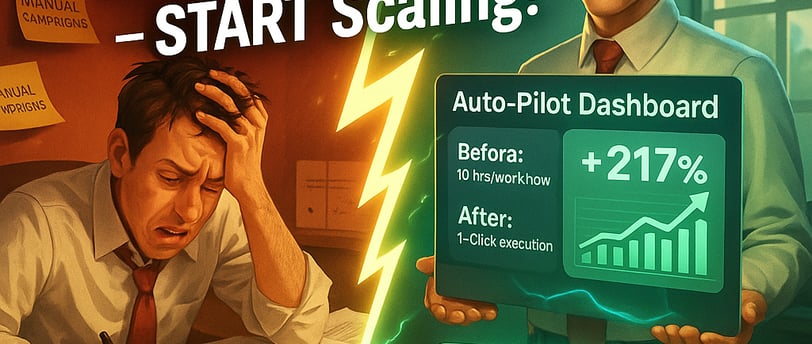The Ultimate Guide to Automating Your Marketing and Driving More Sales
Discover the ultimate guide to automating your marketing processes, increasing efficiency, and driving more sales for your business.
MARKETING AUTOMATION
6/5/20253 min read


Introduction
In today’s digital age, marketing automation has become a cornerstone of successful business strategies. By automating repetitive tasks, you can focus on high-impact activities, deliver personalized experiences, and drive more sales—all while saving time and resources.
But where do you start, and how do you ensure your automation efforts are effective? In this ultimate guide, we’ll walk you through everything you need to know about automating your marketing, from the basics to advanced strategies, and provide actionable tips to help you get started.
What is Marketing Automation?
What It Is: Using software to automate repetitive marketing tasks like email campaigns, social media posts, and ad targeting.
Why It Matters: Automation saves time, reduces errors, and ensures consistent engagement with your audience.
Examples of Marketing Automation:
Sending personalized emails based on user behavior.
Retargeting website visitors with ads.
Automating social media posts and responses.
Benefits of Marketing Automation
Here’s why marketing automation is a game-changer for businesses:
Increased Efficiency: Automate repetitive tasks to free up time for strategic activities.
Improved Personalization: Deliver tailored messages based on customer behavior and preferences.
Higher Conversions: Nurture leads and recover lost sales with automated workflows.
Better ROI: Maximize the impact of your marketing efforts with data-driven automation.
Step 1: Define Your Goals
What It Is: Identifying the specific outcomes you want to achieve with automation.
Why It Matters: Clear goals help you choose the right tools and strategies.
How to Implement:
Set SMART goals (Specific, Measurable, Achievable, Relevant, Time-bound).
Examples: Increase email open rates by 20%, reduce cart abandonment by 15%, or boost lead conversions by 30%.
Pro Tip: Align your automation goals with your overall business objectives.
Step 2: Choose the Right Tools
What It Is: Selecting marketing automation software that fits your needs.
Why It Matters: The right tools make automation seamless and effective.
Popular Marketing Automation Tools:
Email Marketing: Klaviyo, Mailchimp, ActiveCampaign
Social Media: Hootsuite, Buffer, Sprout Social
Ad Retargeting: Google Ads, Facebook Ads, AdRoll
CRM Integration: HubSpot, Salesforce, Zoho CRM
Pro Tip: Start with one tool and expand as your needs grow.
Step 3: Segment Your Audience
What It Is: Dividing your audience into groups based on behavior, demographics, or preferences.
Why It Matters: Segmentation allows for more personalized and effective marketing.
How to Implement:
Use data from your CRM, website analytics, or email campaigns.
Create segments like “First-Time Visitors,” “Repeat Customers,” or “Cart Abandoners.”
Tailor your messaging and offers to each segment.
Pro Tip: Use dynamic content in emails and ads to personalize messages further.
Step 4: Automate Email Marketing
What It Is: Using automation to send targeted emails based on user behavior.
Why It Matters: Email marketing automation increases engagement and conversions.
How to Implement:
Set up welcome emails for new subscribers.
Create abandoned cart recovery emails.
Use drip campaigns to nurture leads over time.
Pro Tip: Test different subject lines, CTAs, and send times to optimize performance.
Step 5: Automate Social Media Marketing
What It Is: Scheduling and automating social media posts and interactions.
Why It Matters: Automation ensures consistent engagement and saves time.
How to Implement:
Use tools like Hootsuite or Buffer to schedule posts in advance.
Automate responses to common questions or comments.
Use analytics to track performance and refine your strategy.
Pro Tip: Focus on platforms where your audience is most active.
Step 6: Retarget and Re-engage
What It Is: Automating ads to target users who have interacted with your site but didn’t convert.
Why It Matters: Retargeting keeps your brand top of mind and encourages users to return.
How to Implement:
Use platforms like Google Ads or Facebook Ads to set up retargeting campaigns.
Segment audiences based on their behavior (e.g., viewed product, added to cart).
Create compelling ad creatives that highlight your unique selling points.
Pro Tip: Use dynamic retargeting ads to show users the exact products they viewed.
Step 7: Measure and Optimize
What It Is: Tracking the performance of your automation efforts and making improvements.
Why It Matters: Continuous optimization ensures your automation strategies remain effective.
How to Implement:
Use analytics tools to track key metrics like open rates, click-through rates, and conversions.
A/B test different elements of your campaigns (e.g., subject lines, CTAs, visuals).
Regularly review and update your automation workflows.
Pro Tip: Set up dashboards to monitor performance in real-time.
Real-World Example: How Automation Drove Sales
Let’s look at a real-world example of how marketing automation helped a business:
The Problem:
An online retailer struggled with low email engagement and high cart abandonment rates.
The Solution:
They implemented email marketing automation to send personalized emails, recover abandoned carts, and nurture leads.
The Results:
The retailer saw a 35% increase in email open rates and a 25% reduction in cart abandonment.
Conclusion
Marketing automation is a powerful tool that can transform your business by increasing efficiency, personalizing customer experiences, and driving more sales. By following this ultimate guide, you can implement automation strategies that deliver measurable results and help your business thrive.
Start automating your marketing today, and unlock the full potential of your business!
